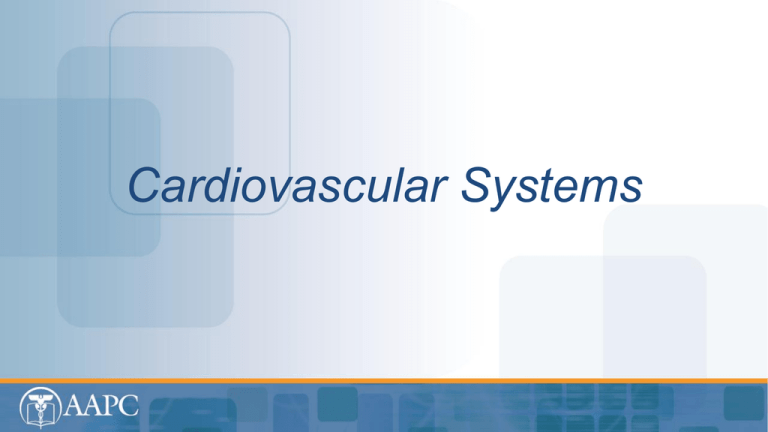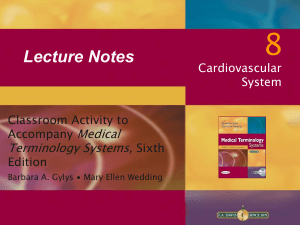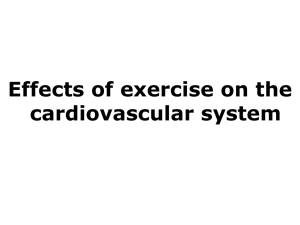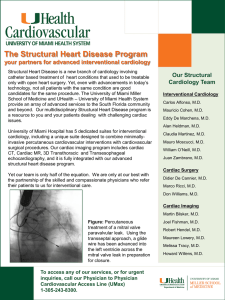
Cardiovascular Systems
Cardiovascular Systems
CPT® copyright 2013 American Medical Association. All rights
reserved.
Fee schedules, relative value units, conversion factors and/or related
components are not assigned by the AMA, are not part of CPT®, and
the AMA is not recommending their use. The AMA does not directly or
indirectly practice medicine or dispense medical services. The AMA
assumes no liability for data contained or not contained herein.
CPT® is a registered trademark of the American Medical Association.
Cardiovascular Systems
2
Objectives
• Master anatomical concepts necessary to understand the
cardiovascular system
• Define key terms, and recognize common eponyms and acronyms
• Explain the most common pathologies that affect this system
• Understand cardiovascular procedures and surgeries, and where in
CPT® to locate the relevant codes
• Introduce ICD-9-CM and HCPCS Level II codes and coding guidelines
as they apply to this system
• Supply examples and review material to improve your application of the
above concepts
Cardiovascular Systems
3
Circulatory Systems
• Systemic Circulatory System
– Blood Vessels
• Arteries
• Veins
•
•
•
•
Pulmonary System
Coronary System
Portal System
Lymphatic System
Cardiovascular Systems
4
Cardiovascular Systems
5
Anatomy
• Arteries
– Carry oxygenated blood
– Take blood away from heart to the body
• Veins
– Carry deoxygenated blood
– Bring blood back to the heart from the capillary beds
• Capillaries
– Connect arteries and veins
Cardiovascular Systems
6
Anatomy
• Anatomy of blood vessels
– Arteries and veins have walls composed of three layers:
• Tunica intima – inner single layer of epithelial cells
• Tunica media – smooth muscle layer
• Tunica adventitia – white fibrous connective tissue
– Veins have less elastic and smooth muscle tissue and more
fibrous connective tissue
– Veins capable of distention to adapt to changes in blood
pressure and blood volume
Cardiovascular Systems
7
Anatomy
• Lymphatic System
– Lymph – fluid collected
– Lymph nodes – small collections of lymphatic tissue
through which lymph fluid is filtered
– Lymphocytes – cells of the immune system
• Right lymphatic duct drains into right subclavian vein
• Thoracic duct drains into left subclavian vein
– Both subclavian veins empty into the inferior vena cava
Cardiovascular Systems
8
Electrical Conduction in the Heart
– Conduction begins in sinoatrial (SA) node of right
atrium Note: View SA node in 2014 CPT Professional,
Cardiovascular System Table of Contents – Page 182
• Nature’s pacemaker
• Firing causes contraction of muscle
– Moves to atrioventricular (AV) node
• Then to bundle of His along septum
– Right and left bundle branches go to each ventricle
• Then to Purkinje fibers along the surface of ventricles
Cardiovascular Systems
9
Circulatory Systems
• Pulmonary Circulation
– Pushes deoxygenated blood into the lungs
– Carbon dioxide removed and oxygen added
– Blood flows to the left atrium
• Systemic Circulation
– Blood flows from left atrium into the left ventricle
– Pumped to the body to deliver oxygen and remove carbon dioxide
• Coronary Circulation
– Movement of blood through the tissue of the heart
Cardiovascular Systems
10
Circulations
• Portal System
– Directs blood from the intestines to the liver
– Liver processes the blood before the blood continues
on to the heart
Cardiovascular Systems
11
Circulatory Systems
• Coronary Circulation
– Right coronary artery (RC)
• Marginal branches
• Posterior interventricular branch (posterior descending)
– Left coronary artery
• Left Main (LM)
• Left circumflex artery (LC)
– Obtuse branches
• Left anterior descending artery (LD)
– Diagonal branches
• Ramus intermedius (RI)
Cardiovascular Systems
12
Great Vessels
• Great vessels
– Aorta
• Brachiocephalic trunk (innominate)
• Left common carotid
• Left subclavian artery
–
–
–
–
Pulmonary trunk which bifurcates to right and left pulmonary arteries
Pulmonary veins (four)
Superior vena cava
Inferior vena cava
Cardiovascular Systems
13
Heart
• Four (4) Chambers
– Two atria
– Two ventricles
• Three (3) layers
– Endocardium
– Myocardium
– Epicardium
• Pericardial sac (double-walled membrane)
– Visceral pericardium
– Parietal pericardium
Cardiovascular Systems
14
Heart
• Pericardium
– Visceral layer adheres to the heart and the first few centimeters of
the outside of the great vessels
– Parietal layer – outer layer
• Pericardial fluid
– Located in space between the visceral pericardium and the
parietal layer
– 10 – 30 ml fluid to lubricate the heart’s surface
– Fluid can increase up to 300 ml without impeding the heart
Cardiovascular Systems
15
Heart
• Cardiac Tamponade
– Compression of the heart caused by build up of
pericardial fluid or blood
– Can lead to cardiac arrest
• Pericardiocentesis
– Procedure to drain fluid from pericardial sac
Cardiovascular Systems
16
Heart Valves
• Atrioventricular valves
– Tricuspid (3 leaflets) – right side of heart
– Bicuspid or Mitral (2 leaflets) – left side of heart
• Chordae tendineae (heart strings) attached to valve leaflets and the papillary
muscles of the ventricle
• Keep valves from everting and provide support during systole
• Semilunar valves
– Pulmonary (Pulmonic)
– Aortic
Cardiovascular Systems
17
ICD-9-CM Coding
•
•
•
•
•
Chapter 01:Infectious and Parasitic Diseases
Chapter 02:
Neoplasms
Chapter 07:
Diseases of the Circulatory System
Chapter 14:
Congenital Anomalies
Chapter 16:Symptoms, Signs, and Ill-Defined Conditions
Cardiovascular Systems
18
Diseases of the Circulatory System
• Acute rheumatic fever (390-392)
– Symptoms include fever, joint pain, lesions of the heart, blood
vessels and joint connective tissue, abdominal pain, skin changes,
and chorea
• Chronic rheumatic heart disease (393-398)
– Persistent inflammation of heart lining due to rheumatic heart
disease.
Cardiovascular Systems
19
Cardiac Cycle
Blood pressure
• Measurement of the pressure of blood exerted within the blood
vessels
- Sphygmomanometer
120/80 mm Hg
120 = Systole
80 = Diastole
Cardiovascular Systems
20
Cardiac Cycle
• Two Phases
– Systole
• Blood is ejected from the ventricles into the body’s
circulatory path (highest pressure against the walls of the
blood vessels)
– Diastole
• Ventricles relax and fill with blood from the atria (lowest
pressure against the walls of the blood vessels)
Cardiovascular Systems
21
ICD-9-CM: Hypertension
• Hypertensive Disease
–
–
–
–
401
402
403
404
Essential hypertension
Hypertensive heart disease
Hypertensive chronic kidney disease
Hypertensive heart and chronic kidney disease
Guidelines I.C.7.a.1. through 11.
Hypertension Table in Alphabetic Index ICD-9-CM
Many guidelines found in the Tabular List for these categories
Cardiovascular Systems
22
ICD-9-CM: Ischemic Heart Disease
• 410 Acute myocardial infarction
– 5th digit
0 Episode of care unspecified
1 Initial episode of care
Regardless of the number of transfers during initial care
2 Subsequent episode of care (8 weeks or less)
STEMI (ST elevation)
NSTEMI (non-ST elevation)
Cardiovascular Systems
23
ICD-9-CM: Ischemic Heart Disease
• 411 Other acute and subacute forms of ischemic heart
disease
• 412 Old myocardial infarction
• 413 Angina pectoris
• 414 Other forms of chronic ischemic heart disease
Use 414.01 CAD/arteriosclerosis when there is no history of
coronary artery bypass surgery.
Cardiovascular Systems
24
ICD-9-CM: Ischemic Heart Disease
• 414.8 Other specified forms of chronic ischemic
heart disease
– Chronic coronary insufficiency
– Ischemia, myocardial (chronic)
– Any condition classifiable to 410 specified as chronic,
or presenting with symptoms after 8 weeks from date
of infarction
Use 411.89 for acute coronary insufficiency
Cardiovascular Systems
25
ICD-9-CM: Ischemic Heart Disease
Example:
A cardiac catheterization is scheduled for a patient who had
an inferoposterior wall infarction 12 weeks ago. She is still
having chest pain, which radiates to the left arm related to
mild exertion.
Look in the Index to Diseases under Disease,
diseased/heart/ischemic 414.9. Check the Tabular List for 414.8.
Because the disease is specified, code 414.8 is correct, not 414.9.
Cardiovascular Systems
26
Occlusion of Arteries
• Occlusion of arteries
414.2x Chronic total occlusion of coronary artery, when coronary artery is
100 percent occluded for several months.
440.4 Chronic total occlusion of artery of the extremities, when there has
been total artery occlusion of the arm or leg.
411.81 Acute coronary occlusion without myocardial infarction. Use 411.81
for occlusion caused by debris.
NOTE: 414.2x and 440.4 and can only be secondary codes
Cardiovascular Systems
27
ICD-9-CM: Aneurysm
• 414.1
–
–
–
–
Aneurysm and dissection of heart
414.10
414.11
414.12
414.19
Aneurysm of heart (wall)
Aneurysm of coronary vessels
Dissection of coronary artery
Other aneurysm of heart
Cardiovascular Systems
28
ICD-9-CM: Heart Disease
•
•
•
•
•
•
•
•
•
•
•
415 – 417 Diseases of pulmonary circulation
420 Acute pericarditis
421 Acute and subacute endocarditis
422 Acute myocarditis
423 Other diseases of pericardium
424 Other diseases of endocardium
425 Cardiomyopathy
426 Conduction disorders
427 Cardiac dysrhythmias
428 Heart Failure
429 Ill-defined descriptions and complications of heart disease
Cardiovascular Systems
29
Congestive Heart Failure
• Congestive heart failure
– Not an inherent component of systolic or diastolic
heart failure.
– When CHF is list with the above, assign two codes
• Systolic, diastolic, or combined systolic/diastolic heart
failure
• CHF, unspecified – 428.0
Cardiovascular Systems
30
ICD-9-CM: Congenital Anomalies
• 745 Bulbus cordis anomalies and anomalies of cardiac septal closure
• 746 Other congenital anomalies of heart
• 747 Other congenital anomalies of circulatory system
Cardiovascular Systems
31
Signs & Symptoms
• 785 Symptoms involving cardiovascular system
–
–
–
–
–
–
–
–
785.0
785.1
785.2
785.3
785.4
785.5X
785.6
785.9
Tachycardia, unspecified
Palpitations
Undiagnosed cardiac murmurs
Other abnormal heart sounds
Gangrene
Shock without mention of trauma
Enlargement of lymph nodes
Other symptoms involving cardiovascular system
• 786.5X Chest pain
–
–
–
–
786.50
786.51
785.52
786.59
Chest pain, unspecified
Precordial pain
Painful respiration
Other
Cardiovascular Systems
32
Terms
•
•
•
•
•
•
•
Apex—bottom point of the heart
Retrograde—against the current
Antegrade—with the current (blood flow)
Cardioversion—shock treatment to the heart
CPR—Cardiopulmonary resuscitation
Tachycardia—rapid beating of the heart
Pacing—refers to electrical activity of the heart
Cardiovascular Systems
33
CPT Coding
•
•
•
Surgical Section - Cardiovascular System — 33010-37799
Heart and Pericardium – 33010-33999
Radiology Section
– Heart – 75557-75574
– Vascular Procedures – 75600-75989
– Diagnostic Ultrasound (various CPTs)
– Radiologic Guidance – 77001-77022
– Nuclear Medicine Diagnostic, Cardiovascular System – 78414-78499
Medicine Section
– Cardiovascular – 92920-93799
– Noninvasive Vascular Diagnostic Studies – 93880-93998
Cardiovascular Systems
34
Pericardium
• Pericardiocentesis (33010-33011)
– Diagnostic test
– Cardiac tamponade
– Radiological supervision and interpretation (76930)
• Pericardotomy for removal of clot/FB (33020)
– Add a note by this code to use 32658 if performed by thoracoscopy
• Pericardial window (33025)
(For thoracoscopy [VATS] pericardial window, use 32659)
Note: an illustration of a cross section of the heart is found on page 182 in the
2014 CPT Professional codebook.
Cardiovascular Systems
35
Pacemakers/Defibrillators (33202- 33264)
• Pacemaker System
– Generator
– Electrodes (leads)
• Note
– Temporary or permanent?
– Single or dual chamber?
– What is being addressed – electrodes, pulse generator, or both?
–NOTE: Temporary pacemakers are noted as “separate procedures”
Cardiovascular Systems
36
Pacemaker or Pacing Cardioverter-Defibrillator
• Permanent Pacemaker system includes:
– a pulse generator (containing electronics and a battery), and one or
more electrodes (leads)
• Generator is placed in a subcutaneous pocket created either in a
subclavicular site, or underneath the abdominal muscles, just below
the rib cage
• Electrodes are inserted through a vein (transvenous), or they may be
placed on the surface of the heart (epicardial) by thoracoscopy or
thoracotomy.
Cardiovascular Systems
37
Pacemaker or Pacing Cardioverter-Defibrillator
• Guidelines
– Replacement of a pacemaker pulse generator:
• Single codes exist for removal and replacement of a single lead system
(33227), a dual lead system (33228) or multiple lead system (33229)
– Replacement of a pacing cardioverter-defibrillator pulse generator
• Single lead system (33262), dual lead system (33263) or multiple lead
system (33264)
Radiological supervision and interpretation related to pacemaker or cardioverterdefibrillator procedure is included in 33206-33264.
Cardiovascular Systems
38
Pacemaker or Pacing Cardioverter-Defibrillator
• Guidelines
– Insertion of new or replacement of permanent pacemaker with
transvenous electrodes(s) (33206-33208)
– Insertion of pacing cardioverter-defibrillator pulse generator with
single, dual, or multiple leads (33240, 33230-33231)
Note: 33230 and 33231 are re-sequenced codes and are out of numerical
sequence.
Cardiovascular Systems
39
Pacemaker or Pacing Cardioverter-Defibrillator
• Biventricular Pacing
– An additional electrode may be required for pacing of left ventricle.
The electrode is placed in the cardiac vein over the left ventricle.
33224 Insertion of pacing electrode, cardiac venous system, for left ventricular pacing,
with attachment to previously placed pacemaker or pacing cardioverter-defibrillator
pulse generator (including revision of pocket, removal, insertion, and /or replacement
of existing generator)
33225 Insertion of pacing electrode, cardiac venous system, for left ventricular pacing,
at time of insertion of pacing cardioverter-defibrillator or pacemaker pulse generator
(eg, for upgrade to dual chamber system)
(When epicardial electrode placement is performed, report 33224 in conjunction with
33202, 33203)
Cardiovascular Systems
40
Pacemaker or Pacing Cardioverter-Defibrillator
Patient underwent removal of a complete dual pacemaker system. A
dual cardioverter-defibrillator system was placed with two transvenous
electrodes, along with a biventricular electrode with use of fluoroscopy.
33249
Insertion of pacing cardioverter-defibrillator leads/generator
33235-51
Removal dual lead system electrodes
33225
Biventricular pacing electrode (this is an add-on code –
modifier 51 is not
applicable)
33233-51
Removal dual system pacemaker generator
Cardiovascular Systems
41
Electrophysiologic Operative Procedures
• Incision (33250-33261)
– Operative tissue ablation codes 33254-33256 are only to be
reported when there is no concurrently performed procedure that
requires median sternotomy or cardiopulmonary bypass
– Use add-on codes 33257-33259 for operative tissue ablation
performed at the time of other cardiac procedures.
• Endoscopy (33265 – 33266)
Cardiovascular Systems
42
Heart (Including Valves) and Great Vessels
• 33300-33335 – repair of cardiac wound and repair
of great vessels
• Great vessels:
–
–
–
–
–
Superior vena cava
Inferior vena cava
Pulmonary artery
Four pulmonary veins
Aorta
Cardiovascular Systems
43
Cardiac Valves (33361-33478)
• Transcatheter aortic valve replacement (TAVR)/
Transcatheter aortic valve implantation (TAVI) (33361-33369)
– Separate codes for transcatheter approaches
– Add-on codes for cardiopulmonary bypass
– Codes include percutaneous access, placing access sheath, balloon aortic
vavluloplasty, advancing the valve delivery system into position, repositioning
valve as needed, deploying the valve, temporary pacing (33210), and closure of
arteriotomy when performed
– These procedures require 2 surgeons – report modifier 62
– Diagnostic coronary angiograms and cardiac catheterization at the same time
may be reported separately if not intrinsic to TAVR/TAVI and guidelines are met.
– Use 33366 for transapical approach (eg, left thoracotomy)
Cardiovascular Systems
44
Cardiac Valve Procedures
•
•
•
•
Aortic Valve (33400-33417)
Mitral Valve (33420-33430)
Tricuspid Valve (33460-33468)
Pulmonary Valve (33470-33478)
Cardiovascular Systems
45
CABG
• Coronary Artery Bypass Graft
–
–
–
–
Venous (33510-33516)
Arterial-Venous (33517-33523)
Arterial (33533-33536)
Reoperation (+33530)
Cardiovascular Systems
46
CABG
• Coronary Artery Bypass using Venous Grafting only (3351033516)
– Used to report coronary artery bypass procedures using venous grafts only
– Not used for combined arteriovenous grafts
– Procurement of the saphenous vein is included in the relative value units for
these codes and not separately reportable unless performed endoscopically
(+33508)
Report procurement of other veins separately
• Upper extremity vein (35500)
• Femoropopliteal vein (35572)
Cardiovascular Systems
47
CABG
Arterial Grafting for Coronary Artery Bypass (33533-33536)
• Arterial includes the use of the following arteries:
–
–
–
–
–
The internal mammary artery
The gastroepiploic artery
The epigastric artery
The radial artery and/or
Arteries procured from other sites
Artery graft from upper extremity is reported separately (35600)
Cardiovascular Systems
48
CABG
Combined Arterial-Venous Grafting for Coronary Artery Bypass
(33517-33530) (33533-33536)
•
To report combined arterial-venous grafts, you must report two
codes:
–
–
The arterial-venous graft code (33517-33523)
The arterial graft code (33533-33536)
Add-on code 33572 Coronary endarterectomy, open
Cardiovascular Systems
49
CABG
Coronary artery bypass with left internal mammary artery to the left
anterior descending, and arterial graft from the left radial artery to the
first diagonal of the LAD. Saphenous vein graft to the ramus
intermedius. Harvesting of the saphenous vein was endoscopic.
33534
33517
35600
33508
2 coronary arterial grafts
1 venous graft
Harvest of upper extremity artery
Harvest by endoscopy
Cardiovascular Systems
50
Cardiac Anomalies (33600-33853)
• Single Ventricle and Other Complex Cardiac Anomalies (3360033622)
• Septal Defect (33641-33697)
• Sinus of Valsalva (33702-33722)
• Venous Anomalies (33724-33732)
• Shunting Procedures (33735-33768)
• Transposition of the Great Vessels (33770-33783)
• Truncus Arteriosus (33786-33788)
• Aortic Anomalies (33800-33853)
Cardiovascular Systems
51
Heart/Lung Transplantation
• 33930-33945
• Distinct Components of Physician Work
– Cadaver donor cardiectomy with or without pneumonectomy
– Backbench work
– Recipient heart with or without lung allotransplantation
Cardiovascular Systems
52
Cardiac Assist
•
Intra-aortic device (33967-33973)
– Insertion and removal codes
•
Ventricular assist device (33975-33983)
– Extracorporeal
– Intracorporeal
• Insertion
• removal
•
Percutaneous assist device (33990-33993)
– Insertion
•
•
Arterial only
Arterial and venous with transseptal puncture
– Removal
– Repositioning
Cardiovascular Systems
53
Aneurysms
•
•
•
•
•
•
•
•
•
•
Abdominal Aorta
Axillary Artery
Basilar Artery
Brachial Artery
Carotid Artery
Celiac Artery
Femoral Artery
Hepatic Artery
Iliac Artery
Innominate Artery
•
•
•
•
•
•
•
•
•
•
Intracranial Artery
Mesenteric Artery
Popliteal Artery
Radial Artery
Renal Artery
Splenic Artery
Subclavian Artery
Thoracoabdominal Aortal
Ulnar Artery
Vertebral Artery
Cardiovascular Systems
54
Aneurysms
Endovascular Repair of Abdominal Aortic Aneurysm
(34800-34834)
•
•
Codes describe open femoral or iliac artery exposure, device manipulation and
deployment, and closure of the arteriostomy sites.
Read guidelines for bundled and additional procedures
Fenestrated Endovascular Repair of the Visceral and Infrarenal Aorta
(34841-34848)
• Fenestrations within the fabric allow for selective catheterization of the visceral and /or renal
arteries and subsequent placement of an endoprosthesis.
Endovascular Repair of Iliac Aneurysm (34900)
•
•
Codes describe open femoral or iliac artery exposure, device manipulation and
deployment, and closure of the arteriostomy sites.
Read guidelines for bundled and additional procedures
Cardiovascular Systems
55
Aneurysms
Direct Repair of Aneurysm or Excision (Partial or Total) and
Graft Insertion for Aneurysm, Pseudoaneurysm, Ruptured
Aneurysm, and Associated Occlusive Disease (35001-35152)
• Separate codes for aneurysm repair and ruptured aneurysm
repair
Cardiovascular Systems
56
Thromboendarterectomy (35301-35390)
Removal of thrombus and inner lining of vessel
• Includes patch graft if performed
• Reported by site
– 35390 Reoperation, carotid, thromboendarterectomy, more than 1
month after original operation.
• Use 35390 in conjunction with 35301
Cardiovascular Systems
57
Transluminal Angioplasty (35450-35476)
• Open
–
–
–
–
Renal or other visceral artery
Aortic
Brachiocephalic trunk or branches, each vessel
Venous
• Percutaneous
–
–
–
–
Renal or visceral artery
Aortic
Brachiocephalic trunk or branches, each vessel
Venous
Code also for catheter placement and radiologic S&I
Cardiovascular Systems
58
Transluminal Angioplasty (35450-35476)
• From a right femoral artery access the catheter was advanced into the
aorta. Transluminal aortic angioplasty was performed.
36200
35472
75966-26
Placement of catheter into aorta
Angioplasty aorta
Radiological supervision and interpretation
Look in the CPT® index for Transluminal/Angioplasty/Arterial/Radiological
Supervision 75962-75968
Catheter placement and S&I will be covered later.
Cardiovascular Systems
59
Bypass Grafts
• Non-coronary vessels
– Vein (35500-35572)
– In-situ vein (35583-35587)
• Vein is left in native location
– Other than vein (35600-35671)
– Composite Grafts (35681-35683)
• Code by type/location
Cardiovascular Systems
60
Vascular Injection Procedures
Endovascular Revascularization
Vascular Injection Procedures and
Endovascular Revascularization
will be discussed in the
Interventional Cardiology/Radiology Section (IVR)
Cardiovascular Systems
61
Central Venous Access (36555-36598)
•
•
Placed for frequent access to bloodstream
Tip of catheter must terminate in the:
–
–
–
–
–
•
Subclavian vein
Brachiocephalic vein
Iliac vein
Inferior or superior vena cava
Right atrium
Code by
–
–
–
–
Procedure (insertion, repair, replacement, removal, etc.)
Tunneled or not
With pump or port
Patient age
See CVAP Table in CPT®
Cardiovascular Systems
62
CPT®
• Hemodialysis (36800-36870)
– See 36147 for diagnostic studies of AV shunts for dialysis
• Portal Decompression (37140-37183)
– Treat hypertension/occlusion of portal vein
– TIPS (37182, 37183) diverts blood from the portal vein to the hepatic vein
– TIPS = transvenous intrahepatic portosystemic shunt(s)
• Transcatheter Procedures
– Removal of clot (thrombectomy)
• Arterial Thrombectomy (37184-37186)
• Venous Thrombectomy (37187-37188)
• Other Procedures (37191-37217)
Foreign body retrieval, placement vena cava filter, transcatheter embolization, stent placement, etc.
Cardiovascular Systems
63
Interventional Procedures
• Interventional Cardiology/Radiology
– Branch of medicine
– Minimally invasive techniques using imaging guidance to diagnose
and treat diseases
– Catheter is threaded into vessels to perform procedure(s)
– Multiple codes may be used from different sections of CPT® (eg,
Surgery, Radiology, and Medicine)
Cardiovascular Systems
64
Vascular Injection Procedures (36000-36660)
• Vascular Injections include the following:
– Local anesthesia
– Introduction of the needle or intracatheter
– Injection of contrast material
– All pre- and post-injection patient care
– Closure of vascular access
Cardiovascular Systems
65
Vascular Injection Procedures
• Intravenous
– Nonselective – venography, superior or inferior vena cava
– Selective
• First order
• Second order
• Intra-Arterial - Intra-Aortic Procedures
– Nonselective
– Selective
Cardiovascular Systems
66
Vascular Injection Procedures
Five Vascular Families:
•
•
•
•
•
Systemic Arterial
Systemic Venous
Pulmonary
Portal
Lymphatic
Cardiovascular Systems
67
Vascular Injection Procedures
• Non-Selective catheterization
– Catheter is placed directly into an arterial or venous vessel
and not moved or manipulated further (36100, 36120, 36140)
– Or the catheter is moved only into the aorta from any aterial
approach (36200)
– Introduction of needle/catheter arteriovenous shunt created for
dialysis (36147)
– Introduction of needle or intracatheter, aortic, translumber
(36160)
Cardiovascular Systems
68
Vascular Injection Procedures
• Selective Catheterization
– Catheter is moved, manipulated or guided into a part of the
arterial/venous system other than the aorta or the vessel
punctured.
– The exact code used depends on how many branches the
catheter must be guided through before it reaches the ultimate
injection site.
See CPT® Appendix L Vascular Families for first, second, third order, and
beyond third order branches based on a starting point in the aorta.
Cardiovascular Systems
69
Selective Catheterization
Vascular Families
•
•
•
Primary (first turn off the main highway [aorta])
– First-order vessels (eg, innominate/brachiocephalic artery, left common
carotid, left subclavian)
Secondary (second turn off the main highway [aorta])
– Second-order vessels, (eg, right common carotid artery, left external
carotid, left vertebral [aorta])
Tertiary (third turn off the main highway [aorta])
– Third-order vessels, (eg, right external carotid artery, right vertebral)
Cardiovascular Systems
70
Cardiovascular Systems
71
Selective Catheterization
Vascular Access Rules
•
•
•
From a single access catheter puncture site, selective catheterization takes precedence in
coding over the nonselective catheterization. Only report highest order of one family. If other 2nd
or 3rd levels catheterized in same family, use add-on code
Code for each vascular family accessed
Code for each vascular access
– Above diaphragm (36215-36218)
•
Additional second and/or third order use add-on code 36218
– Below diaphragm (36245-36248)
•
•
Additional second and/or third order use add-on code 36248
Pulmonary angiography involves the right and left pulmonary arteries representing two vascular
families
Cardiovascular Systems
72
Selective Catheterization
Part I (Surgical)
•
From a right femoral access, code the selective catheterization of the common
hepatic artery. Check Appendix L for the vascular family order starting from the aorta.
36246
•
From a right femoral access the catheter is advanced into the aorta just above the
renal arteries. Next the catheter is manipulated into the superior mesenteric artery
(visceral artery), and then into the inferior mesenteric artery. 36245, 36245-59.
•
From a right femoral access, code the selective catheterization of the right internal
thoracic, and the right ulnar artery. 36217, 36218
Cardiovascular Systems
73
Selective Catheterization
Part 2 – Vascular Procedures Radiology
• Vascular Procedures Radiology (75600-75989)
– Use when physician provides both surgical and radiology portion of an interventional
service
– Modifier 26 Professional component may be required
– Use modifier 26 when services performed in a facility/hospital setting or when equipment
not owned by provider
• Radiology Guidelines
– Do not use diagnostic angiography radiologic supervision and interpretation (S&I) with
interventional procedures for:
•
•
•
•
Roadmapping (taking a look)
Vessel measurement
Post-angioplasty/stent angiography follow-up
Intervention procedures which include S&I
Cardiovascular Systems
74
Selective Catheterization
Part 2 – Vascular Procedures Radiology
• Report diagnostic interventional procedures when:
–
–
–
–
Performed at separate setting
No prior angiography study is available
Prior study is available, but patient’s condition has changed
There is inadequate visualization of anatomy and/or pathology
Cardiovascular Systems
75
Selective Catheterization
Part I (Surgical) & Part 2 (Radiological)
Part 1 (surgical)
From a right femoral access a catheter was placed in the aorta (nonselective 36200) and aortography is
performed. Next the catheter is manipulated into the celiac artery and angiography is performed. Check
Appendix L. This is first order (36245). Code 36200 is dropped, because you only code to the highest level of
catheter placement.
36245
Selective catheter placement, arterial system; each first order abdominal, pelvic, or lower extremity
artery
branch, within a vascular family
Part 2 (Radiology)
The celiac artery is a visceral artery. Look in the CPT index for Angiogram/Abdominal and you will see a range
of codes.
75726
Angiography, visceral, selective or supraselective (with or without flush aortogram), radiological
supervision and interpretation
Modifier 26 is required for the professional service. The aortography is bundled.
36245, 75726-26
Cardiovascular Systems
76
Selective Catheterization
Part I (Surgical) & Part 2 (Radiological)
Take the previous example of the diagnostic angiography of the celiac artery. During the study a
stenosis of 85% is found and the decision is made to insert a stent.
Look in the CPT® index for Transcatheter/Placement/Intravascular Stent 0075T-0076T, 3721537217, 37236-37239, 93928-92929.
37236
Transcatheter placement of an intravascular stent(s) (except lower extremity, cervical
carotid, extracranial vertebral or intrathoracic carotid, intracranial, or coronary), open or
percutaneous, including radiological supervision and interpretation and including all
angioplasty within the same vessel, when performed, initial artery
Part 1 (surgical) 37236
Part 2 (Radiological) Radiological supervision and interpretation are included in the surgical code
37236, 36245, 75726-26-59. Modifier 59 is needed to show that this angiography was diagnostic
and not included in the stent procedure.
Cardiovascular Systems
77
Diagnostic Studies of Cervicocerebral Arteries
(36221-36228)
• Diagnostic studies of the cervicocerebral arteries include:
–
–
–
–
–
–
–
Nonselective and selective arterial catheterization
Diagnostic imaging of the aortic arch, carotid, and vertebral arteries
Contrast injection
Fluoroscopy
Radiological interpretation and supervision
Closure of arteriotomy by pressure or closure device
Interventional procedures during the same session are coded separately
Cardiovascular Systems
78
Diagnostic Studies of Cervicocerebral Arteries
(36221-36228)
+36227 Selective catheter placement, external carotid artery, unilateral, with angiography of
the ipsilateral external carotid circulation and all associated radiological supervision
and interpretation (List separately in addition to code for primary procedure)
(Use 36227 in conjunction with 36222, 36223, or 36224)
(Do not report 36221-36227 in conjunction with 37217 for ipsilateral services)
+36228 Selective catheter placement, each intracranial branch of the internal carotid or
vertebral arteries, unilateral, with angiography of the selected vessel circulation and
all associated radiological supervision and interpretation (eg, middle cerebral artery,
posterior inferior cerebellar artery) (List separately in addition to code for primary
procedure)
(Use 36228 in conjunction with 36224 or 36226)
(Do not report 36228 more than twice per side)
Cardiovascular Systems
79
Diagnostic Studies of Cervicocerebral Arteries
(36221-36228)
• Do not report 75774 as part of diagnostic angiography of the
extracranial and intracranial cervicocerebral vessels.
• Report 76376 or 76377 for 3D rendering when performed in conjunction
with 36221-36228.
• Report 76937 for ultrasound guidance for vascular access when
performed in conjunction with 36221-36228.
The codes in the surgery section do not have a professional and technical component.
Cardiovascular Systems
80
Endovascular Revascularization
(37220-37235)
• Treat occlusive disease in lower extremities
• Three territories
– Illiac
– Femoral/Popliteal
– Tibial/Peroneal
• Codes arranged in a hierarchy for each territory
–
–
–
–
Stent placement with atherectomy (highest)
Atherectomy
Stent placement
Angioplasty (lowest)
Cardiovascular Systems
81
Bundled to Endovascular Revascularization
(37220-37235)
–
–
–
–
–
Conscious sedation
Vascular access
Catheter placement
Traversing the lesion
Imaging related to the intervention (previously billed as the supervision
and interpretation code for the specific intervention)
– Use of an embolic protection device (EPD)
– Imaging for closure device placement
– Closure of the access site
Cardiovascular Systems
82
Endovascular Revascularization
(37220-37235)
•
Iliac vascular territory codes do not include atherectomy
– Use Category III codes 0234T-0238T for atherectomy in the suprainguinal vessels (iliacs, visceral, aorta, renal, brachiocephalic)
– Codes include radiological supervision and interpretation
– Codes do not include:
•
•
•
•
•
Selective catheterization of vessel
Traversing lesion
Embolic protection, if used
Other intervention used to treat the same or other vessels
Closure of arteriotomy by any method
Cardiovascular Systems
83
Endovascular Revascularization
(37220-37235)
From a left femoral access, a stent was placed and
atherectomy was performed in the right common iliac.
0238T
Transluminal peripheral atherectomy, open or percutaneous,
including S&I; iliac artery, each vessel
37221 Revascularization, endovascular, open or percutaneous, iliac
artery,
unilateral, initial vessel, with transluminal stent
placement(s)
36245 is not included in 0238T; however, it is not reported, because the same access is used
for 37221.
Cardiovascular Systems
84
Endovascular Revascularization
(37220-37235)
From a right femoral artery access, report stent placement in
left superficial femoral artery, and angioplasty of the left
popliteal artery.
37226 Revascularization, endovascular, open or percutaneous,
femoral,
popliteal, unilateral; with transluminal
stent placement(s),
includes angioplasty within the
same vessel, when performed.
The entire femoral/popliteal territory is considered a single vessel for
revascularization procedures.
Cardiovascular Systems
85
Endovascular Revascularization
(37220-37235)
From a right femoral artery access, report the stenting of the
right peroneal trunk, and angioplasty of the dorsalis pedis
artery and posterior tibial artery.
37230 Revascularization, endovascular, open or percutaneous,
tibial,
peroneal artery, unilateral, initial vessel;
with transluminal
stent placement(s)
37232 x2 each additional vessel; with transluminal angioplasty
Cardiovascular Systems
86
Endovascular Revascularization
(37220-37235)
• Guidelines for treatment of one extremity
– Report initial vessel intervention at the highest level of intervention
• Hierarchy from highest to lowest: stent placement with atherectomy, stent placement,
atherectomy, angioplasty
– Report initial vessel intervention for each intervention performed within a different
territory
– Intervention of additional vessels within a territory are reported with add-on codes
– Bridging lesions are considered a single-vessel intervention, even if the bridging
lesion extends from one territory into another.
– Diagnostic imaging is separately billable.
– Other interventions such as IVUS, thrombolysis, thrombectomy, and embolization
are separately billable.
Cardiovascular Systems
87
Medicine Section
Cardiovascular (92920-93799)
•
Therapeutic services and procedures
– Other Therapeutic Services and Procedures
– Coronary Therapeutic Services and Procedures
•
•
•
•
•
•
•
•
•
Cardiography
Cardiovascular monitoring services
Implantable wearable cardiac device evaluations
Echocardiography
Cardiac Catheterizations
Intracardiac Electrophysiological Procedures/Studies
Peripheral Arterial Disease Rehabilitation
Noninvasive physiologic studies and procedures
Other procedures
Cardiovascular Systems
88
Other Therapeutic Services and Procedures
• Cardiopulmonary resuscitation
– Includes defibrillation
– Includes treatment to the pulmonary system
– Not considered a component of critical care services
• Cardioversion
– Electrical shock delivered to the heart to convert an abnormal heart
rhythm back to a normal rhythm (elective)
Cardiovascular Systems
89
Cardiovascular Therapeutic Services and Procedures
(92920-92979)
• Thrombolysis—Dissolving of a blockage by a thrombus (clot)
in a vessel
• Coronary stent—wire metal mesh tube placed inside an
artery to hold the vessel open
• Angioplasty—dilate and open a blocked artery
• Atherectomy—procedure to remove plaque from arteries
Cardiovascular Systems
90
Cardiovascular Therapeutic Services and Procedures
(92920-92979)
•
Coronary artery therapeutic procedure guidelines:
– Three coronary arteries are recognized and ramus intermedius arteries
•
•
•
Right coronary (RC)
Left anterior descending (LD)
Left circumflex (LC)
– Only one procedure reported per coronary vessel
•
•
•
Access through a coronary bypass graft is reported separately
Each bypass graft represents a coronary vessel
Each sequential bypass graft with more than one distal anastomosis represents only on graft
– Up to 2 coronary artery branches of LD (diagonals), LC (marginals), and RC (posterior
descending, posterolaterals) are recognized
•
Report with add-on codes
– Hierarchy from highest to lowest value:
•
•
92943=92941=92933>92924>92937=92928>92920 for base interventions
92943=92941=92933>92924>92937=92928>92920 for add-on codes.
Cardiovascular Systems
91
Coronary Therapeutic Services and Procedures
(92920-92979)
• Percutaneous coronary intervention (PCI) include:
–
–
–
–
–
Accessing, selective catheterization of vessel
Traversing lesion
Radiologic supervision and interpretation related to intervention(s)
Closure of arteriotomy
Imaging to document completion
Do not report diagnostic cardiac catheterization codes (93454-93461) and injection procedures
(93563-93564) with 92920-92944) unless diagnostic cardiac catheterization is required prior to
the intervention service. See guidelines in CPT®.
Cardiovascular Systems
92
Coronary Therapeutic Services and Procedures
(92920-92979)
If a single lesion extends from one major coronary artery to another
target vessel, but can be revascularized with a single intervention
bridging the two vessels, report a single code.
Example:
Left main coronary lesion extends into the proximal left circumflex and
a single stent is placed across the entire lesion
92928-LC Percutaneous transcatheter placement of intracoronary stent(s),
with coronary angioplasty when performed; single major
coronary artery or branch
Cardiovascular Systems
93
Coronary Therapeutic Services and Procedures
(92920-92979)
When a bifurcation is treated, PCI is reported for both vessels treated.
Example:
A bifurcation lesion involving the left anterior descending artery and the
first diagonal artery is treated by stenting both vessels.
92928-LD, 92929-LD
Cardiovascular Systems
94
Coronary Therapeutic Services and Procedures
(92920-92979)
Example:
Angioplasty in the right coronary and stent placement in the left circumflex,
with atherectomy in the left anterior descending coronary artery.
Intravascular ultrasound (IVUS) was used in each vessel.
92924-LD, 92928-LC, 92920-RC, 92978, 92979, 92979-59
Cardiovascular Systems
95
Monitoring Heart Activity
• Cardiography (93000 – 93042)
– Codes for professional component, technical component, and global
• Cardiovascular Monitoring Services (93224-93278)
• Implantable and Wearable Cardiac Device Evaluations (93279-93299)
– For the 90-day period, do not report for less than 30 days
– For the 30-day period, do not report less than 10 days
• Cardiac Stress Tests
– Activity or pharmaceutical
– Codes for global, technical, and professional components.
Cardiovascular Systems
96
Echocardiography (93303-93352)
• Diagnostic ultrasound of the heart
• M-mode recording – used to measure chamber dimensions and to
establish the timing of events
• Doppler echocardiography – records the direction and velocity of blood
flow
• Color-flow mapping – allows images of the blood to be displayed
– Transthoracic (TTE) or esophageal (TEE)
– Note congenital echo
– Complete or limited study
Cardiovascular Systems
97
Cardiac Catheterizations (93451-93583)
• Most common access point – femoral artery
• Right or left heart catheterization?
• Catheter insertion, injection(s), and imaging are combined
in one code
Cardiovascular Systems
98
Cardiac Catheterizations (93451-93583)
Cardiac Catheterization
• There are two code families for cardiac catheterization:
– Congenital heart disease
– All other conditions
Anomalous coronary arteries, patent foramen ovale, mitral valve prolapse,
and bicuspid aortic valve are to be reported with 93451-93464, 93566-93568.
Cardiovascular Systems
99
Cardiac Catheterizations (93451-93583)
•
•
•
•
•
•
For cardiac catheterization for congenital anomalies, see 93530-93533.
When contrast injection(s) are performed in conjunction with cardiac
catheterization for congenital anomalies, see 93563-93568.
Cardiac catheterization (93451-93461) includes all roadmapping angiography
in order to place the catheters, including any injections and imaging
supervision, interpretation, and report. It does not include contrast injection(s)
and imaging supervision, interpretation and report for imaging that is
separately identified by specific procedure code(s).
For supravalvular aortography, use 93567.
For pulmonary angiography, use 93568.
Cardiac catheterization procedures have a technical and professional
component
Add-on codes for injection procedures are professional services; therefore, no
modifier
Cardiovascular Systems
100
Cardiac Catheterizations (93451-93583)
From a right femoral access, right and left cardiac catheterization was
performed, with coronary angiography, and angiography of bypassed
vessels, with right and left ventriculography. Injection procedure was
performed to view the aortic cuff for possible aneurysm. Report the
physician service.
93461-26, 93566, 93567
Cardiovascular Systems
101
Cardiac Anomalies
• Septal Defect – hole in the septum (or wall) of the heart
separating the atria and ventricles
• Repair of Septal Defect
– 93580-93583
– Transcatheter Closure
• Read the notes for this section
• Codes include cardiac catheterization
Cardiovascular Systems
102
Intracardiac Electrophysiological Procedures/Studies
• 93600-93662
• Percutaneous
• Indications - Cardiac arrhythmias causing:
• Palpitations—irregular heart beats
• Syncope—loss of consciousness
• Cardiac arrest
Cardiovascular Systems
103
Intracardiac Electrophysiological Procedures/Studies
• There are codes for:
–
–
–
–
Diagnostic electrophysiologic studies
Mapping
Ablation
Diagnostic electrophysiologic studies with ablation
during the same session
Cardiovascular Systems
104
Peripheral Arterial Disease (PAD) Rehabilitation
• Rehabilitation is reported per session
• Narrowing or blockage of the arteries in the legs
• Symptoms:
– Cramping
– Aching
– Numbness
Cardiovascular Systems
105
Noninvasive Vascular Diagnostic Studies
(93880-93998)
•
•
•
•
•
Cerebrovascular Arterial Studies
Extremity Arterial Studies (Including Digits)
Extremity Venous Studies (Including Digits)
Visceral and Penile Vascular Studies
Extremity Arterial-Venous Studies
Most of the studies in this section are considered bilateral. If a unilateral study is performed, use
modifier -52. 93924 describes a complete bilateral study of lower extremity arteries
Cardiovascular Systems
106
Modifiers
•
•
•
•
•
•
•
•
•
•
26 – Professional Component
TC – Technical Component
LM – Left Main
RI – Ramus intermedius
LC – Left Circumflex Coronary Artery
LD – Left Anterior Descending Coronary Artery
RC –Right Coronary Artery
80 – Assistant Surgeon
51 – Multiple Procedures
52 – Reduced Services
Cardiovascular Systems
107
The End
Cardiovascular Systems









